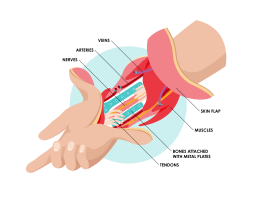First in Finland hand transplantation performed at HUS
Keywords:Finland’s first hand transplantation was performed at HUS Meilahti Bridge Hospital in November. The operation went as planned and the patient will be discharged soon.

During the attachment surgery, the bones and blood vessels are connected first. Then, the tendons, nerves, and other structures are attached. HUS / Vesa Sammalisto
Finland's first hand transplantation operation took about 17 hours. “We transplanted one hand to a patient who has had both hands and legs amputated years ago,” says Jorma Ryhänen, professor and head physician in hand surgery.
Hand transplantation is a very demanding procedure
A hand transplantation operation consists of three separate surgeries: detaching the hand from the donor, preparatory surgery of the recipient, and attaching the transplant. During the attachment, the bones and blood vessels are connected first. Then, the tendons, nerves, and other structures are attached. There are dozens of different structures that need to be attached.
Globally, hand and arm transplantations have been done to the wrist-level and below or above the elbow. The operation is planned individually for each patient. “The longer the recipient’s stump, the smaller the transplanted section needs to be, and the better the expected functional result. Our first patient's transplant was attached below the elbow,” explains Ryhänen.
Careful preparations and long rehabilitation
Before the transplantation, the patient underwent extensive examinations to find out if they are suitable for the operation. After the surgery, the patient was in intensive care for about a week and on a general ward for several weeks. In future, the patient still needs to undergo rehabilitation, which will last over a year. They will also have several follow-ups in the hospital to monitor function and sense of touch in the transplant, as well as the overall health of the patient.
The criterion for a successful transplantation is that function in the nerves and muscles recover. “In wrist-level transplants, flexion and extension in the fingers recover usually fairly reliably. Sense of touch in the fingertips is also to be expected. However, grip strength, fine motor skills, and sensation will be poorer than in a normal hand. It is still too early to assess these in our patient’s case but so far everything seems good,” Ryhänen clarifies.
Injuries and infections lead to hand amputations
Prosthetic arms have developed tremendously in recent decades, but lack of sensation, clumsiness, and reliability still pose challenges. Hand or arm transplantations are usually performed on patients who do not have functioning hands. “Hands may be amputated due to deep infections and various injuries, such as burns or battlefield injuries,” Ryhänen says.
The donor of a body part must be compatible with the recipient in many ways. In addition to tissue compatibility, the donor's sex, skin color, and age need to be considered.
Results in hand transplantations abroad have been good
The first ever hand transplantation was performed in France in 1998. In Western countries, nearly 200 vascularized composite allotransplantations (VCA) have been performed, and about 120 of them have been hand transplantations. VCAs are not life-saving procedures, but the aim is to significantly improve the patient's quality of life.
“The best functional results have been achieved in wrist-level transplantations where the patient's own, functional muscles in the forearm can move the fingers via the transplanted tendons soon after the surgery,” Ryhänen explains.

Long preparation
Preparations for the first hand transplantation surgery in Finland were long. Led by Jorma Ryhänen, a team of hand, plastic, and transplantation surgeons, pathologists, anesthesiologists, nurses, and other specialists in various units have been preparing for the operation for several years.
HUS's surgeons practiced the operation on cadavers and visited other countries to learn about hand transplantations. The transplantation of one hand required two surgical teams.
Next step: established hand transplantations
“Hand transplantation requires a multitude of resources and deep knowledge of several medical specialties. A hospital needs to have established organ transplantation operations and a high-quality hand surgery unit to be able to perform hand transplantations. Now that the first hand transplantation has been successfully completed, the next step is to establish hand transplantations as part of the services HUS provides,” says Chief Medical Officer Markku Mäkijärvi.
The HUS media service is available for the media Mon–Thu 10:00 a.m.–4:00 p.m. and Fri 10:00 a.m.–3:00 p.m., tel. 050 427 2875, or via e-mail: viestinta@hus.fi.